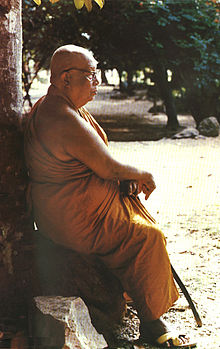Buddhadasa
Phra Dharmakosacarya rtgs 160Phra Thammakosachan , also known as Buddhadasa Bhikkhu was a famous and influential asceticphilosopher of the 20th century. Known as an innovative reinterpreter of Buddhist doctrine and Thai folk beliefs, Buddhadasa fostered a reformation in conventional religious perceptions in his home country, Thailand, as well as abroad. Although he was a formally a bhikkhu or monk, having at the age of twenty years submitted to mandatory traditional religious controls, Buddhadasa developed a personal view that rejected specific religious identification and considered all faiths as principally one. His groundbreaking thought inspired such persons as the French schooled Pridi Banomyong, leader of the Siamese revolution of 1932, and a group of Thai social activists and artists of the 1960s and 70s.
He was born Nguam Phanit in 1906 in Ban Phumriang, Chaiya District, southern Thailand. His father, Sieng Phnit, was a shopkeeper of second generation Thai Chinese ancestry and his mother, Klaun, was Thai. He renounced civilian life in 1926. Typical of young monks during the time, he traveled to the capital, Bangkok, for doctrinal training but found the wats there dirty, crowded, and, most troubling to him, the sangha corrupt, preoccupied with prestige, position, and comfort with little interest in the highest ideals of Buddhism. As a result, he returned to his native rural district and occupied a forest tract near to his village. He named it Suan Mokkh from Thai suan garden and Pali moksha release, liberation. He strove for a simple, pristine practice in attempt to emulate Gautama Buddhas core teaching, Do good, avoid bad, and purify the mind. He therefore avoided the customary ritualism and internal politics that dominated Siamese clerical life. His ability to explain complex phil
Source: Wikipedia

